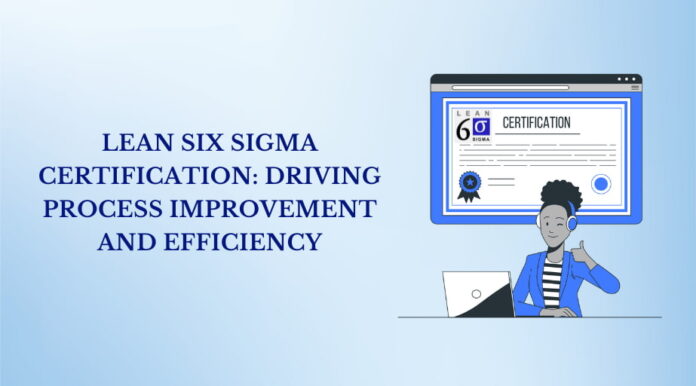In today’s highly competitive business landscape, organisations are constantly seeking ways to enhance efficiency, reduce costs, and improve customer satisfaction. One powerful methodology that has gained widespread recognition is Lean Six Sigma. By combining the principles of Lean manufacturing and Six Sigma, this approach offers a systematic and data-driven framework for process improvement. In this blog, we will explore the significance of Lean Six Sigma Certification, with a particular focus on the Lean Six Sigma Green Belt, and how it can drive process improvement and efficiency within an organisation.
Table of Contents
- Understanding Lean Six Sigma
- The Importance of Lean Six Sigma Certification
- The Lean Six Sigma Green Belt
- The Benefits of Lean Six Sigma Green Belt Certification
- Conclusion
Understanding Lean Six Sigma
Lean Six Sigma is a disciplined approach that aims to identify and eliminate process inefficiencies, defects, and variations that can hinder business performance. Lean principles concentrate on streamlining processes by minimising waste, reducing cycle times, and optimising resource utilisation. On the other hand, Six Sigma focuses on identifying and reducing variations in processes through data analysis and statistical tools, ultimately leading to improved quality and customer satisfaction.
The Importance of Lean Six Sigma Certification
To effectively implement Lean Six Sigma principles and techniques, organisations often rely on professionals who possess the necessary knowledge and skills. Obtaining a Lean Six Sigma certification demonstrates an individual’s proficiency in these methodologies and provides them with a comprehensive toolkit to drive process improvement initiatives. Certification acts as a testimony to one’s expertise, opening doors to career advancement and increased job prospects in various industries.
The Lean Six Sigma Green Belt
Among the different levels of Lean Six Sigma certification, the Green Belt holds immense value. A Lean Six Sigma Green Belt possesses a solid understanding of the core principles and tools required to lead process improvement projects within an organisation. They act as valuable team members, collaborating with Black Belts and project sponsors to identify improvement opportunities, collect and analyse data, and implement solutions.
The Benefits of Lean Six Sigma Green Belt Certification
1- Enhanced Process Efficiency: Lean Six Sigma Green Belts possess the knowledge to identify and eliminate wasteful activities, bottlenecks, and non-value-added steps in processes. By applying Lean techniques, they can streamline workflows, reduce cycle times, and enhance overall process efficiency.
2- Improved Quality and Reduced Defects: Green Belts are trained in Six Sigma methodologies, enabling them to identify root causes of defects and variations. Through rigorous data analysis and statistical tools, they can implement targeted solutions to reduce defects and enhance product or service quality.
3- Cost Reduction: By eliminating waste and improving process efficiency, Lean Six Sigma Green Belts contribute to significant cost savings. They can identify unnecessary expenses, optimise resource utilisation, and reduce rework or scrap, resulting in improved financial performance for the organisation.
4- Increased Customer Satisfaction: Lean Six Sigma focuses on aligning processes with customer requirements and expectations. Green Belts leverage tools like Voice of the Customer analysis and process mapping to identify and address pain points, resulting in enhanced customer satisfaction and loyalty.
5- Effective Problem Solving: Green Belts are equipped with a range of problem-solving tools, such as root cause analysis, process mapping, and hypothesis testing. These tools enable them to systematically approach and solve complex problems, driving sustainable process improvements.
6- Change Management: Lean Six Sigma Green Belts understand the importance of change management when implementing process improvement initiatives. They possess the skills to engage stakeholders, communicate effectively, and facilitate a smooth transition, ensuring acceptance and sustainability of the implemented changes.
7- Leadership Development: Lean Six Sigma Green Belt certification not only equips professionals with technical skills but also enhances their leadership abilities. Green Belts learn how to effectively lead teams, manage projects, and drive a continuous improvement culture within an organisation.
8- Competitive Advantage: In today’s competitive business landscape, organisations that embrace Lean Six Sigma principles gain a significant competitive advantage. Lean Six Sigma Green Belts play a crucial role in driving process improvements, cost reduction, and customer satisfaction, positioning their organisations as industry leaders.
9- Collaboration and Cross-Functional Skills: Lean Six Sigma Green Belts often work in multidisciplinary teams, collaborating with individuals from different departments and backgrounds. This collaboration fosters a culture of cross-functional problem-solving, allowing for a holistic approach to process improvement. Green Belts learn to navigate diverse perspectives, communicate effectively, and leverage the collective knowledge of the team to achieve successful outcomes.
10- Continuous Improvement Culture: Lean Six Sigma Green Belts contribute to the establishment of a continuous improvement culture within an organisation. They become advocates for ongoing evaluation and enhancement of processes, promoting a mindset of continuous learning and innovation. This culture not only drives efficiency and effectiveness but also fosters employee engagement and satisfaction.
11- Global Recognition: Lean Six Sigma certification is globally recognised and respected. Organisations operating on a global scale value professionals with Lean Six Sigma Green Belt certification, as it demonstrates a commitment to quality, efficiency, and customer satisfaction.
12- Return on Investment (ROI): Lean Six Sigma Green Belt certification offers a substantial return on investment for both individuals and organisations. The skills and knowledge gained through certification lead to improved processes, cost savings, enhanced quality, and increased customer satisfaction, all of which contribute to the bottom line and organisational success.
Conclusion
Lean Six Sigma certification, particularly the Lean Six Sigma Green Belt, is a valuable asset for professionals and organisations seeking to drive process improvement and efficiency. It equips individuals with the knowledge, tools, and methodologies required to identify waste, reduce defects, enhance quality, and deliver optimal customer satisfaction. By embracing Lean Six Sigma principles and obtaining certification, individuals can become catalysts for change within their organisations, leading to long-term success and competitive advantage in today’s dynamic business environment. Investing in Lean Six Sigma certification is a strategic decision that yields substantial returns in terms of improved processes, reduced costs, enhanced customer experiences, the establishment of a culture of continuous improvement, and global recognition. With Lean Six Sigma Green Belts at the forefront, organisations can achieve operational excellence and thrive in an ever-evolving marketplace.
Read Also
- How to Drive Growth Through Customer Centricity in HealthcareThe world of healthcare is changing in big ways. Consumers are now stepping up and taking charge of their health journeys. This change is happening now for important reasons. The U.S. health and wellness market is huge, projected to be over $6 trillion in 2025. This growth is fueled by rising out-of-pocket costs and more… Read more: How to Drive Growth Through Customer Centricity in Healthcare
- Why Biotech Companies Choose Contract Manufacturing Organizations for Scalable GrowthBiotech and pharmaceutical companies are under constant pressure to innovate, scale fast, and stay compliant. Doing everything in-house can slow them down. That’s why many are turning to a contract manufacturing organization to handle specialized production needs—especially in genetic and molecular biology fields. Reliable CMOs offer speed, precision, and regulatory knowledge. For early-stage firms, this… Read more: Why Biotech Companies Choose Contract Manufacturing Organizations for Scalable Growth
- Maximizing Digital Reach for Podiatry Clinics in Local HealthcareMaximizing Digital Reach for Podiatry Clinics in Local Healthcare As the healthcare industry evolves, mobile marketing becomes indispensable for practitioners. Podiatry clinics, focusing on foot and ankle care, must adapt to digital strategies to engage patients effectively. Implementing tailored SEO practices is crucial for these clinics to thrive in an increasingly competitive market. Digital marketing… Read more: Maximizing Digital Reach for Podiatry Clinics in Local Healthcare
- How to Start a Mental Health Conversation with Your ManagerTalking about mental health at work can feel awkward, intimidating, or even risky. But if you’re struggling, keeping it bottled up isn’t going to make things better. Having an open and honest conversation with your manager can be a game-changer, whether you need accommodations, support, or just someone to understand what you’re going through. This… Read more: How to Start a Mental Health Conversation with Your Manager
- How Efficient Business Contracts Can Boost GrowthIn the business world, efficiency isn’t just a buzzword—it’s a necessity for survival and growth. Every facet of a company can contribute to greater efficiency, but some often-overlooked areas hold substantial potential. Business contracts, particularly those loaded with bureaucratic jargon, can slow down operations. Streamlining these can free up resources and time, allowing for greater… Read more: How Efficient Business Contracts Can Boost Growth
- The Future of Digital Marketing: Key Trends and StrategiesDigital marketing has evolved from being a secondary tool for businesses to becoming the backbone of global commerce. Today, organizations cannot ignore the rapid changes shaping the industry, from AI-powered tools to hyper-targeted strategies that meet consumers where they are. Whether you’re a startup aiming for visibility or an established brand looking to retain customer… Read more: The Future of Digital Marketing: Key Trends and Strategies







